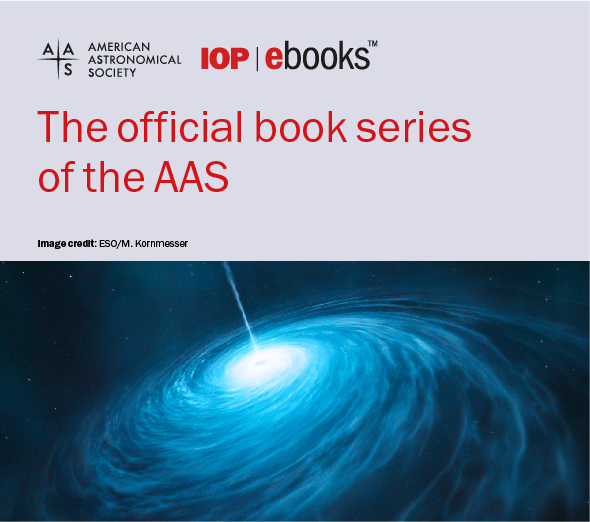The most critical element of data citation is the citation of the specific source of a dataset used in a new manuscript and the citation of that data’s reference publication as required by the data creator’s. By specific source of the data, we mean that if data is available from many sources, the one that must be cited is the one that was used to obtain the data. By reference publication, we mean that journal article (or other technical document) that describes the dataset used and is specified by the creators of a dataset as the preferred citation. We provide below a series of templates to highlight the various types of relationships that exist between reference publications and specific sources of data.
AAS Journal Table citation
The AAS Journals now provide individual dataset DOIs and a dataset landing page for articles with online-only content. In this citation example, an author is reusing the machine-readable table that has a dataset DOI in the published article. The resulting text gives attribution to the data creators by citing the reference publication (journal article) and gives precise information about the source of the data used, leading the reader directly to that data via the dataset citation.
We used CO (1-0) rovibrational line fluxes published by D. A. Dickson-Vandervelde et al. (2025a) in the original machine-readable format (D. A. Dickson-Vandervelde et al. 2025b, Table 2).
In LaTeX, using ADS bibcodes or dataset DOIs as reference keys
We used CO (1-0) rovibrational line fluxes published by \citet{2025AJ….170..130D} in the original machine-readable format \citep[][, Table 2]{doi:10.3847/1538-3881/ade80e/data2}.
If a Table does not have a dataset DOI, e.g., because it does not have an online-only component or because that online-only component does not have a DOI, then best practice is to mention simply the Table by number:
We used the joint fit for WASP-130 published by \citet{2025AJ….170…70E} (their Table 6).
In this example, the author is referring to one of a specific set of online-only Figures previously published in the AAS Journals. The set has a DOI, and it can be cited in bulk. The specific element of the set must be provided in free text.
This geometry is clearly suggested by the self-absorbed CO emission of CW Tau (D. A. Dickson-Vandervelde et al. 2025a; their online Figure 6.6, D. A. Dickson-Vandervelde et al. 2025c).
In LaTeX, using ADS bibcodes and component DOIs as reference keys:
This geometry is clearly suggested by the self-absorbed $^{12}$CO emission of CW Tau (\citealias{2025AJ….170..130D}; their online Figure 6.6, \citealias{doi:10.3847/1538-3881/ade80e/data3}).
Citing the Vizier version of a Table published in the AAS Journals
In this example, a data table originally published in the AAS journals has been ingested and hosted by the Vizier service at the Strasbourg astronomical Data Center. Tables ingested into Vizier are significantly more interoperable than the version hosted in the Journals, including enabling the data to be used directly in the Virtual Observatory and by Python tools such as astroquery. As before, the goals of a data citation are to attribute first the creators of the data and, second, to give precise information about the source of the data used, leading the reader directly to that data via the dataset citation.
It is not relevant whether or not the original Table had a dataset DOI from the Journal article. An author in this case is referring specifically to that version of the data hosted by Vizier. The Vizier version of the data may or may not match the original table. All AAS journal data hosted by Vizier has a Vizier-assigned DOI, which should be used for making the citation:
We used the catalog TESS-based short-period variables published by G. Olmschenk et al. (2024) as provided by Vizier (G. Olmschenk et al. 2025).
In LaTeX, using ADS bibcodes and component DOIs as reference keys:
We used the catalog TESS-based short-period variables published by \citet{2024AJ….168…83O} as provided by Vizier \citep{doi: 10.26093/cds/vizier.51680083}.
Citing data on Zenodo
We include this example because authors are increasingly hosting large or unique datasets on third-party repositories, such as Zenodo.
The AAS Journals support data sharing in all venues, and we provide a workflow that allows us to assist and curate such Zenodo-based data publications. When posting data to services such as Zenodo, please review the repository best practices in our Data Guide and consider submitting unpublished data for review by our Data Editor Team via the AAS Journal’s Zenodo community.
Again, the principle focus is the citing of both the reference journal article and the corresponding published dataset:
M. S. Marley et al. (2021a) present the cloudless, rainout chemical equilibrium models “Sonora Bobcat”; we made use of these models as published on Zenodo (M. S. Marley et al. 2021b).
In LaTeX, using ADS bibcodes and Zenodo DOIs as reference keys:
\citet{2021ApJ…920…85M} present the cloudless, rainout chemical equilibrium models “Sonora Bobcat”; we made use of these models as published on Zenodo \citep{doi:10.5281/zenodo.5063476}.
Citing data hosted in NASA archives
These examples highlight the practice of citing datasets obtained from high-level science products hosted by NASA archives such as the Barbara A. Mikulski Archive for Space Telescopes (MAST) and IPAC.
Not yet added




